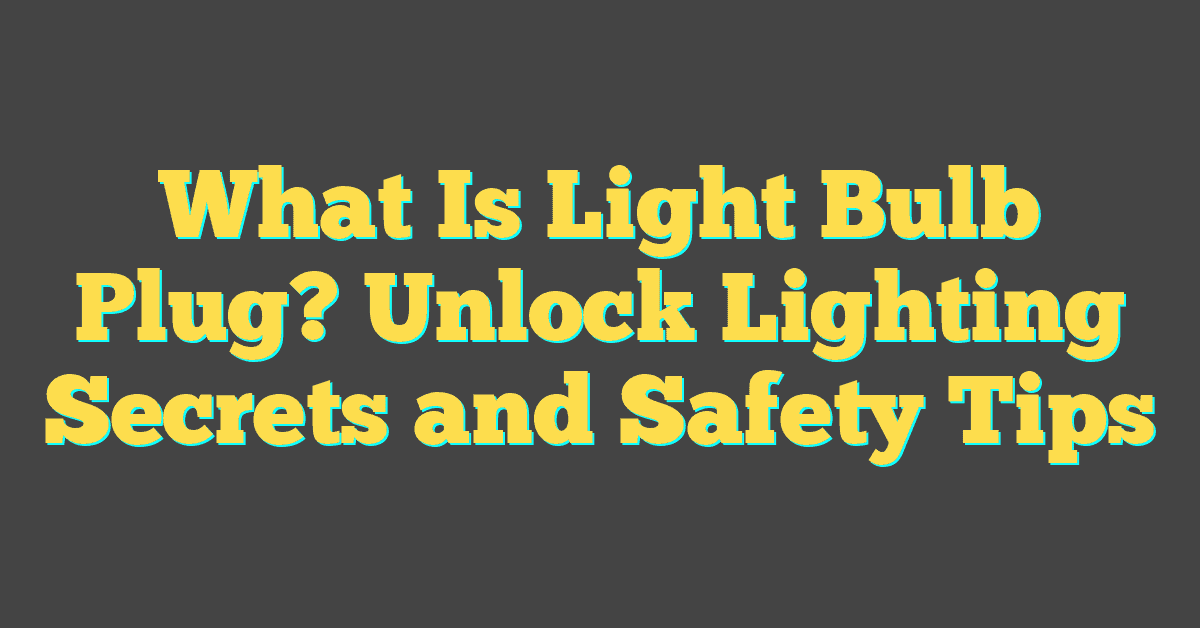You’ve probably heard the buzz about LED light bulbs—they’re energy-efficient, long-lasting, and all the rage in modern homes. But amidst the glowing reviews, you might be wondering if they’re actually safe to use.

With traditional bulbs taking a backseat, LEDs are stepping into the spotlight. Let’s shed some light on the safety of these high-tech illuminators, so you can brighten up your space without a worry.
As you swap out the old for the new, it’s crucial to understand what you’re bringing into your home. Stick around as we delve into the ins and outs of LED light bulb safety. You’ll be equipped with the knowledge to make an informed decision on lighting up your life.
The Benefits of LED Light Bulbs
As you dive deeper into the world of home lighting, LED light bulbs stand out not just for their efficiency but also for their multitude of benefits. For an enthusiast like you who revels in DIY projects, understanding these advantages can help you make the best lighting choices for your home.
Lower Energy Consumption
One of the most compelling perks of LED light bulbs is their incredibly low energy use. LED bulbs are designed to consume significantly less electricity than traditional incandescent bulbs. They’re capable of turning about 70% of their energy into light, making them a powerful ally in reducing your monthly energy bills.
Longevity Unmatched by Traditional Bulbs
LED light bulbs take the cake when it comes to lifespan. These bulbs can last up to 25 times longer than their incandescent counterparts. This means you won’t be climbing up ladders to replace bulbs all the time, nor will you need to buy replacements as often.
Durability
For a DIY enthusiast, knowing that your creations can stand the test of time is vital. LED bulbs are solid-state lights, which means they’re more resistant to shock, vibrations, and external impacts. Whether you’re installing them in a garage workshop or a cozy reading nook, LEDs can handle the hustle and bustle of everyday life.
Environmentally Friendly
LEDs don’t contain mercury, a win for both your health and the planet’s. They are also recyclable, adding a green touch to your eco-friendly projects. By using LED bulbs, you’re helping to lessen the amount of toxic elements released into the environment.
Unleash a Spectrum of Possibilities
With LED lights, you’re not just limited to bright white light. You can find bulbs that range from warm, inviting hues to crisp, invigorating tones. This versatility allows you to match the light to the mood or functionality of any room. Whether you’re setting up a home theater, ambient bedroom lighting, or bright workspaces, LEDs offer the freedom to tailor your environment precisely to your liking.
Understanding LED Light Bulb Safety

When you’re engaged in a home DIY project, safety is always a top priority. As a light bulb enthusiast with a knack for indoor and outdoor lighting projects, you’ll find that LED light bulbs are highly regarded for their safety features. Unlike traditional light bulbs that get extremely hot to the touch and pose a burn hazard, LED bulbs emit very little heat. This reduces the risk of accidental burns during handling and installation.
LEDs are free from hazardous substances, such as mercury, that are found in other types of bulbs like compact fluorescents (CFLs). This makes them a safer choice for your home and the environment. In case an LED bulb breaks, you don’t have to worry about toxic mercury exposure. Here’s a quick glance at why LEDs are a safer option:
- Low Heat Emission: Minimizes fire risk and burn injuries.
- No Hazardous Substances: No mercury or harmful chemicals involved.
- Durable Design: Less prone to breakage due to solid state components.
Yet, as with any electrical product, there are a couple of safety considerations. Ensure that your LED bulbs are compatible with your light fixtures and dimmers to avoid electrical issues. Overloading circuits with too many bulbs can still pose a fire risk, so make sure to follow the manufacturer’s specifications.
Additionally, looking directly at the intense light emitted by an LED can potentially cause discomfort or harm to your eyes. It’s a good habit to avoid staring at these powerful lights when they’re on.
When it comes to LED light bulb safety, you’re probably getting the gist — they’re a reliable, low-risk option for brightening up your home. Keep in mind that safety doesn’t end with the bulb choice. Proper handling and correct usage play crucial roles in ensuring a safe and well-lit environment.
« Can Light Bulbs Be Stored Outside? Protect Your Investment with These Tips
Is LED Light Bulb Good for Eyes? Easy Tips to Protect Your Vision »
Remember these tips the next time you’re on the ladder, swapping out an old bulb, or planning that new lighting installation to give your living space a fresh, vibrant look.
The Low Heat Factor

When you’re dealing with home lighting, you’ve likely come across one of the most significant benefits of LED light bulbs – their ability to remain cool during operation. Unlike traditional incandescent bulbs, which can get incredibly hot to the touch, LEDs produce minimal heat. This is because they are highly efficient in converting electricity into light, not wasting energy on generating unnecessary heat.
You may not think much about the heat output of your bulbs, but it’s a vital aspect of home safety. Especially if you’re a DIY enthusiast who loves to keep your home cozy and well-lit. Excessive heat from bulbs can pose a fire risk – think of those old floor lamps with the incandescent lights that you dared not leave on for too long. LED bulbs mitigate this hazard significantly, allowing you to brighten up any space without the fear of overheating.
From a practical standpoint, the low heat factor of LEDs means your air conditioning doesn’t have to work overtime. During those warm summer months, traditional bulbs can contribute to higher indoor temperatures, leading to increased cooling costs. Your LED bulbs, on the other hand, help maintain a cooler environment, keeping your home comfortable and your utility bills down.
Let’s delve into why that’s crucial for the longevity of your fixtures. Heat can degrade many materials over time. By using LEDs, your lampshades and light fixtures will likely last longer since they’re not subjected to the chronic stress of heat. Moreover, this makes LEDs an ideal choice for sensitive areas like art galleries or any space where preservation is paramount. They thoroughly light up the space while safeguarding the integrity of heat-sensitive objects.
Remember, with any lighting, proper installation and regular check-ups are part of your safety net. Ensure that your LED bulbs are securely fitted in their sockets and that there’s no flickering which can indicate a problem. That way, you keep enjoying the cool advantages of LED lighting without a hitch.
The Mercury Myth

You might’ve heard rumors about the dangers lurking in the energy-efficient lighting options of the past. Compact fluorescent lights (CFLs), for example, contain a small amount of mercury—which can be a genuine concern if a bulb breaks. But when it comes to LED bulbs, the worry about mercury is unfounded.
LEDs do not contain mercury, making them a safer choice for your home. In the home DIY world, this is particularly comforting. You can install or change numerous LED bulbs without fear of exposing yourself or your family to this hazardous substance. This is a significant advantage, especially in households with children or pets, where accidents can occur.
Aside from the lack of mercury, LED bulbs also present minimal environmental hazards when disposed of. Their remarkable energy efficiency means you’re already reducing your carbon footprint by using them. When it comes time to replace them—and remember, that’s quite a few years down the line compared to traditional bulbs—you’ll be pleased to know that you’re contributing less waste to landfills.
If you’re passionate about both the environment and DIY projects, choosing LED bulbs is a no-brainer. The peace of mind that comes with a mercury-free lighting solution enables you to focus on the creative aspects of lighting design in your home. From crafting the perfect ambient light in your living room to accentuating your garden features, LEDs provide you with a versatile and safe medium to work with.
And let’s not forget the indemnity against mercury contamination if an LED bulb breaks. Unlike CFLs, where a breakage necessitates specific clean-up procedures to handle the mercury risk, LEDs can be cleaned up without special equipment. It’s one less thing to worry about while you’re standing on that ladder, replacing a bulb or adding an artistic touch to your lighting fixtures.
Flickering and Dimming Issues

You might’ve noticed that some light bulbs tend to flicker or dim over time, an issue that could be mildly annoying or seriously disruptive depending on the environment. With LED bulbs, flickering can occur, but it’s often less about the bulb quality and more about your home’s electrical systems. Incompatible dimmer switches are a common culprit here. Many LED bulbs are designed to be compatible with dimmers, but it’s essential to pair them with LED-rated dimmer switches. Traditional dimmers designed for incandescent bulbs can cause LEDs to flicker because they don’t handle the lower wattage of LEDs effectively.
Another issue to consider is voltage fluctuations in your home’s electrical supply. Even slight changes can sometimes make your LEDs flicker, which doesn’t necessarily mean your bulbs are faulty. To address this, you could upgrade your electrical system or install voltage stabilizers.
Here’s the thing, while it’s true that all light sources may flicker, LED technology has advanced to a point where flicker rates are incredibly low and often imperceptible to the human eye. This advancement ensures your DIY home project or cozy reading nook isn’t disrupted by inconsistent lighting. Should you experience flickering with a new bulb, it’s worth checking the fixture and connections, sometimes a loose bulb or wiring can be the simple fix.
Dimming issues can be another headache. If you’re into dimly lit ambiance or want to reduce energy use, you’ll want your LED bulbs to dim smoothly. Make sure your bulbs are labeled as dimmable; non-dimmable LEDs won’t play nice with dimmer switches and can lead to flickering or failure to adjust the light level. Moreover, the dimming range of LED bulbs varies, so for the best results, pair your LEDs with switches that have an adjustable range to find that perfect lighting level for each of your spaces.
Remember, the vast majority of LED flickering and dimming issues can be resolved with proper installation and matching components. With a keen eye on details, your LED-lit home will shine bright, flicker-free, and just the way you intend.
Conclusion
Rest assured, LED light bulbs are not only safe but they’re a fantastic choice for your home or office. They’re eco-friendly, durable, and long-lasting, ensuring you get the most bang for your buck. If you’re facing flickering or dimming, it’s usually a quick fix with the right dimmer switch or a check on voltage fluctuations. Embrace the LED revolution and enjoy a brighter, safer, and more efficient lighting experience.
Frequently Asked Questions
What are the main benefits of LED light bulbs?
LED light bulbs offer numerous benefits, including lower energy consumption, increased longevity, enhanced durability, environmental friendliness through less energy waste, and a variety of light color options. They are also safer than traditional bulbs due to lower heat emissions and no mercury content.
How do LED bulbs contribute to safety?
LED bulbs contribute to safety in two main ways: they generate very little heat, reducing the risk of burns or fire, and they do not contain hazardous substances like mercury, making them safer for the environment and human health.
Can LED light bulbs flicker or dim?
Yes, LED light bulbs can sometimes experience flickering or dimming issues. These problems can often be linked to incompatible dimmer switches, voltage fluctuations, or poor installation. However, advancements in LED technology have significantly reduced the occurrence of flicker rates.
How can flickering and dimming issues with LED bulbs be resolved?
Flickering in LED bulbs can be addressed by ensuring they are compatible with the existing dimmer switches or by stabilizing the voltage supply. Dimming issues can be resolved by using LED bulbs designed to be dimmable and pairing them with switches that support an adjustable dimming range.
Is it difficult to install LED light bulbs correctly?
Proper installation of LED light bulbs is straightforward and does not typically require special expertise. However, to avoid flickering and dimming issues, it’s crucial to match the LED bulb with compatible components and follow the manufacturer’s instructions for installation.




